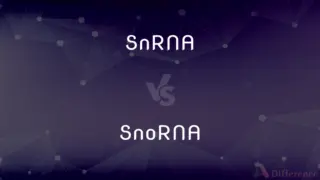Molecular Distillation vs. Short Path Distillation — What's the Difference?
By Tayyaba Rehman — Published on November 2, 2023
Molecular Distillation operates under high vacuum for separation without heating; Short Path Distillation uses a short distance for vapor to travel at reduced pressure.

Difference Between Molecular Distillation and Short Path Distillation
Table of Contents
ADVERTISEMENT
Key Differences
Molecular Distillation and Short Path Distillation are specialized techniques used to separate components based on their molecular properties and boiling points. Molecular Distillation operates under extremely high vacuum conditions, ensuring that the separation occurs at temperatures much lower than the boiling points of the compounds. This is particularly useful for temperature-sensitive compounds. On the contrary, Short Path Distillation involves a process where the distillate travels a short distance, reducing the potential for compound degradation.
Diving deeper, Molecular Distillation stands out due to its capability to handle highly viscous and heat-sensitive materials. This distillation technique operates at such a high vacuum that the normal boiling point of the material becomes irrelevant. The main advantage of Molecular Distillation lies in its ability to produce high purity products with minimal thermal degradation. Conversely, Short Path Distillation utilizes a shorter distance for the vapor phase to travel, making it efficient for the separation of compounds with closer boiling points.
Another point of differentiation is the apparatus used. Molecular Distillation employs a high precision wiper system that spreads a thin film of the material over a heated surface. This aids in the efficient separation of compounds under reduced temperature conditions. In contrast, Short Path Distillation uses a straightforward apparatus with a short path for the vapors to travel, reducing potential compound loss and maintaining purity.
In summation, while both Molecular Distillation and Short Path Distillation aim to achieve separation of components, the methods and principles they rely upon are distinct. The choice between them often depends on the specific requirements of the separation process, considering factors like the nature of the compounds, their boiling points, and their sensitivity to heat.
Comparison Chart
Operating Pressure
Extremely high vacuum
Reduced pressure, but not as high as molecular distillation
ADVERTISEMENT
Temperature
Operates at temperatures below normal boiling points
Operates closer to boiling points due to short path
Apparatus Design
Uses wiper system to spread material over a heated surface
Simple design with a short vapor travel path
Primary Use
Separation of heat-sensitive and viscous materials
Efficient separation of compounds with closer boiling points
Thermal Degradation
Minimal due to high vacuum and low temperature operation
Potential for more thermal degradation compared to molecular distillation
Compare with Definitions
Molecular Distillation
Molecular Distillation is ideal for viscous and sensitive materials.
They chose Molecular Distillation for the temperature-sensitive organic compound.
Short Path Distillation
Short Path Distillation involves a minimal vapor travel distance.
The Short Path Distillation apparatus ensures quick vapor condensation.
Molecular Distillation
Molecular Distillation results in high-purity products.
For ultra-pure extracts, they opted for Molecular Distillation.
Short Path Distillation
Short Path Distillation operates at reduced pressure.
They used Short Path Distillation to separate compounds with close boiling points.
Molecular Distillation
Molecular Distillation operates at conditions avoiding boiling points.
Molecular Distillation ensures minimal thermal degradation of compounds.
Short Path Distillation
Short Path Distillation has a straightforward apparatus design.
The setup for Short Path Distillation was simpler than other methods.
Molecular Distillation
In Molecular Distillation, a wiper system aids in the separation process.
The precision wiper in Molecular Distillation spreads the mixture evenly.
Short Path Distillation
Short Path Distillation is efficient for compounds with similar properties.
For separating isomers, they preferred Short Path Distillation.
Molecular Distillation
Molecular Distillation is a high-vacuum distillation method.
They used Molecular Distillation to process the heat-sensitive oil.
Short Path Distillation
Short Path Distillation maintains compound purity.
The essential oil retained its aroma after Short Path Distillation.
Common Curiosities
Can Molecular Distillation handle viscous materials?
Yes, Molecular Distillation is ideal for separating highly viscous materials.
Are there risks of compound degradation in Short Path Distillation?
While there's potential for more thermal degradation compared to Molecular Distillation, the short path helps mitigate these risks.
Which distillation method uses a wiper system?
Molecular Distillation employs a wiper system to spread the material.
What apparatus does Short Path Distillation use?
It uses a simple design with a short path for the vapors to travel.
How does pressure affect Molecular Distillation?
It operates under extremely high vacuum conditions, ensuring separation at reduced temperatures.
What is the primary advantage of Molecular Distillation?
Molecular Distillation allows for separation at temperatures below the normal boiling points, minimizing thermal degradation.
What makes Short Path Distillation unique?
Its short vapor travel path allows efficient separation of compounds with close boiling points.
Which distillation method would be best for separating isomers?
Short Path Distillation is often preferred for compounds with close boiling points, such as isomers.
Is Short Path Distillation suitable for temperature-sensitive compounds?
While it's more suitable than traditional methods, Molecular Distillation is often a better choice for highly temperature-sensitive compounds.
How does Short Path Distillation ensure efficient separation?
In Short Path Distillation, the vapor travels a minimal distance, reducing compound loss and maintaining purity.
How does Short Path Distillation differ from traditional distillation?
Short Path Distillation involves a reduced vapor travel distance, which makes it efficient for separating compounds with similar properties.
Can both methods achieve high purity?
Yes, both Molecular and Short Path Distillation can yield high-purity products, but the method chosen depends on specific separation needs.
Can both methods be used for large-scale industrial processes?
Both Molecular and Short Path Distillation can be scaled, but the choice depends on the material's properties and the desired outcome.
What role does the wiper system play in Molecular Distillation?
The wiper system in Molecular Distillation helps in spreading a thin film of material over a heated surface, ensuring efficient separation.
Why is Molecular Distillation preferred for heat-sensitive materials?
Molecular Distillation operates under high vacuum, allowing separations at temperatures well below the boiling points, thus protecting heat-sensitive materials.
Share Your Discovery

Previous Comparison
Trench Coat vs. Overcoat
Next Comparison
SnRNA vs. SnoRNAAuthor Spotlight
Written by
Tayyaba RehmanTayyaba Rehman is a distinguished writer, currently serving as a primary contributor to askdifference.com. As a researcher in semantics and etymology, Tayyaba's passion for the complexity of languages and their distinctions has found a perfect home on the platform. Tayyaba delves into the intricacies of language, distinguishing between commonly confused words and phrases, thereby providing clarity for readers worldwide.












































